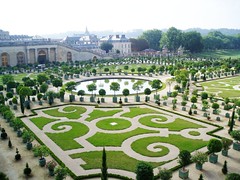The Palace of Versailles is a royal château in Versailles, in France's Île-de-France region. In French, it is known as the Château de Versailles. When the château was built, Versailles was a country village; today, however, it is a suburb of Paris, some twenty kilometers southwest of the French capital.
From 1682, when Louis XIV moved from Paris, until the royal family was forced to return to the capital in 1789, the court of Versailles was the centre of political power in France. Versailles is therefore famous not only as a building, but as a symbol of the system of absolute monarchy of the Ancien Régime.
By moving his court and government to Versailles, Louis XIV hoped to extract more control of the government from the nobility, and to distance himself from the population of Paris. All the power of France emanated from this centre: there were government offices here, as well as the homes of thousands of courtiers, their retinues, and all the attendant functionaries of court (Solnon, 1987). By requiring that nobles of a certain rank and position spend time each year at Versailles, Louis prevented them from developing their own regional power at the expense of his own and kept them from countering his efforts to centralize the French government in an absolute monarchy (Bluche, 1986, 1991; Bendix, 1978; Solnon, 1987). The meticulous and strict court etiquette that Louis established, which overwhelmed his heirs with its petty boredoms, was epitomized in the elaborate ceremonies and exacting procedures that accompanied his rising in the morning, known as the Lever, divided into a petit lever for the most important and a grand lever for the whole court. Like other French court manners, étiquette was quickly imitated in other European courts (Benichou, 1948; Bluche, 1991; Solnon, 1987).
In 1789 France was shaken by the citizen's uprising known as the French Revolution.
On 6 October 1789, the royal family left Versailles and returned to the Tuileries Palace in Paris. During the early years of the French Revolution, preservation of the palace was largely in the hands of the citizens of Versailles. Eventually the opulent furnishings were dispersed; there was a long period of neglect of the palace.
Upon his appointment as conservator of the museum in 1892, Pierre de Nolhac embarked on a campaign of research, conservation, preservation, and restoration that continues to this day. The Rockefeller donations to Versailles made between 1924 and 1936 ensured the preservation of the palace and the Trianons.
However, it would not be until after the Second World War that concerted governmental initiatives directed at preservation and restoration of the palace would be undertaken.
Subscribe to:
Post Comments (Atom)


No comments:
Post a Comment